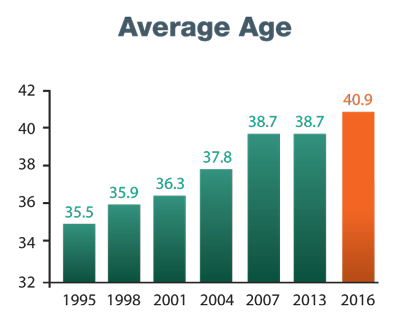Clark Plucinski, executive director of the Foundation, details results from the organizations recent Snapshot of the Collision Repair Industry research and how what has been learned influences their programs designed to improve the industry’s supply of entry level employees.
Since 1995, the Collision Repair Education Foundation has conducted its Snapshot of the Collision Repair Industry survey roughly every three years to provide insight into employment statistics and confirm trends. In January, the Foundation, in conjunction with I-CAR, released its Executive Summary for its 2016 Snapshot of the Collision Repair Industry research effort and recently posted the full report on its website.
In our video interview below, Clark Plucinski, executive director of the Collision Repair Education Foundation explains some of the key trends evident in the most recent study including the aging workforce, the growth in repair facilities and number of unfilled positions facing facility operators.
The concern over the aging workforce in the collision repair industry is one of the key factors that led the industry to create the Foundation, originally called the I-CAR Education Foundation, in 1991.
 As the chart at right shows, in 1995, when the Foundation conducted its first Snapshot survey, the average age of technicians was 35.5 years old. In both 2007 and 2013 reports (the study was not conducted in 2010) the survey reported the average age of technicians had increased to 38.7 in both studies. In the 2016 research, the age jumped to 40.9 years old an increase of over 15 percent during the 20 years covered by the study.
As the chart at right shows, in 1995, when the Foundation conducted its first Snapshot survey, the average age of technicians was 35.5 years old. In both 2007 and 2013 reports (the study was not conducted in 2010) the survey reported the average age of technicians had increased to 38.7 in both studies. In the 2016 research, the age jumped to 40.9 years old an increase of over 15 percent during the 20 years covered by the study.
Replacing the nearly 12,000 technicians that leave the trade for another industry, a related job within the industry or retired, is just one of the concerns uncovered by the research.
Plucinski explained that the 2016 survey also asked collision repair shops to identify the number of unfilled positions at their facilities. Respondents reported an average need for 0.9 entry-level employees and 1.67 experienced employees per facility. Additionally, facilities need 0.45 entry-level non-production staff and 0.89 experience non-production staff.
One troubling area in the 2016 research was the decline in the percentage of facilities offering health benefits to their employees. In 2016, the percentage reporting they offered health benefits declined from the record 77.9 percent of respondents in 2013 to 68.8 percent in 2016. This remarks a retreat toward percentages reported in 2001-2007.
However, a record low 2.5 percent of repair facilities reported offering no benefits,
Plucinski also explains that the research work the Collision Repair Education Foundation undertakes, like the Snapshot survey, but also studies of schools, helps guide the Foundation’s work to improve education opportunities for the industry’s future workforce.
Criteria used for the Foundation’s tiered school designation system that was launched last year was developed based upon research of common factors such as contact hours, equipment levels, curriculum and other items that improved the changes of student success and employment in the industry. This year, the Foundation recognized 121 schools under the new program. The Foundation’s school grant programs are now geared towards helping schools achieve higher tiers and rewarding them more generously once they reach the top level.